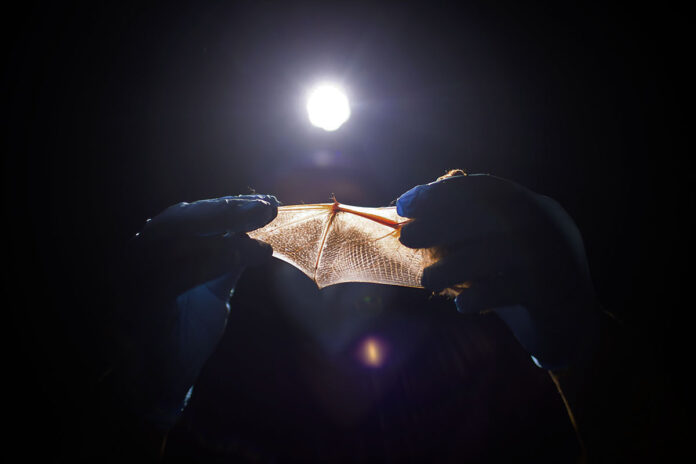 Clarksville, TN – Shortly after nightfall as the day’s steam lifted from a wooded Fort Campbell creek, a man’s voice stabbed through the cricket cacophony.
Clarksville, TN – Shortly after nightfall as the day’s steam lifted from a wooded Fort Campbell creek, a man’s voice stabbed through the cricket cacophony.
“We’ve got one!” Austin Peay State University (APSU) graduate student Brandon Gulley crackled over the radio.
Moments later fellow graduate student Leah Crowley responded, “I have one too!” And another voice joined, “We have one!”
And the six mist nets that Dr. Catherine Haase’s team erected over those pathways had captured three red bats just seconds apart. Within 20 minutes, the team had netted three more bats – an evening bat, a gray bat, and a tricolored bat.
Gulley, Crowley, and fellow APSU student Dakota Van Parys retrieved the bats from the nets and brought them to an Austin Peay field research truck for a flurry of scientific activity. They recorded the bats’ species, age, sex, and mass.
“This is a female,” Haase said about the red bat that Gulley retrieved. “She is lactating because around her nipples, there’s a lot of hair loss where the babies have nursed. They’re either at the roost or they’ve already flown off.”
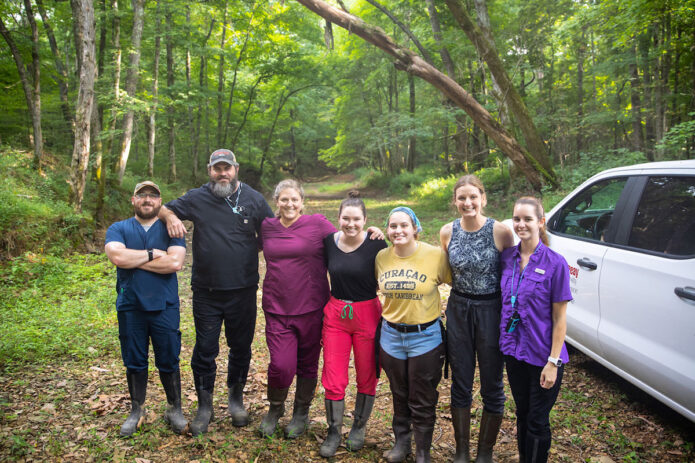
In just two hours, Haase and her team captured and inspected 12 bats – six red bats, three evening bats, a tricolored bat, and two gray bats. The night was the most productive night during the summer.
The team – all recent or current Austin Peay State University biology students – also inspected the bats for diseases such as white-nose syndrome, tagged the tricolored bat with a temporary tracking device and banded the gray bats.
The information that Haase and her team collect during these trips contributes to a three-year partnership that Austin Peay State University has with Fort Campbell to survey the Army installation for endangered bat species. Fort Campbell officials will use the information to make a conservation plan to protect the places where endangered bats roost and forage. About 85% of the installation comprises natural habitats such as forests, grasslands, streams, lakes and wetlands.
But Haase’s students also gain information and practice in other research areas, including the effect water quality has on insect biomass and bat diversity and how white-nose syndrome affects reproductive patterns and bat diversity.
Tracking the Bats
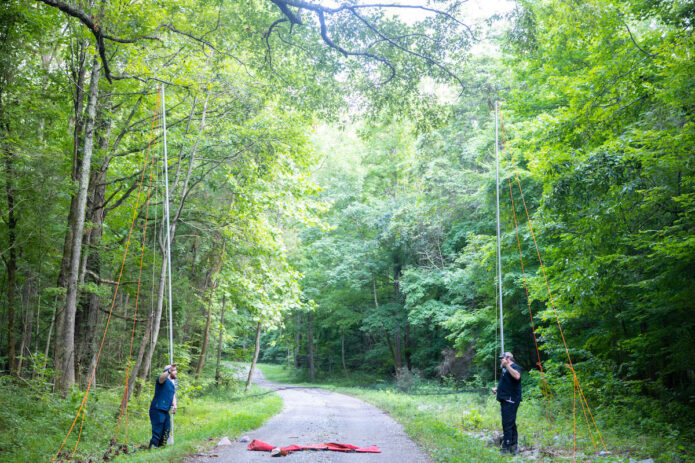
The team’s tracking devices – which fall off after about a week – help Haase and her students record the bats’ roosting patterns.
Every morning for the next seven days, the team took turns using radiotelemetry to track the tricolored bat they tagged on July 18 to its roost, usually nearby trees.
On July 20th, Leah Crowley, a new member of the team pursuing her master’s degree, and Jessica Verrillo tracked one of the tricolored bats to its roost tree. The trek wasn’t far from the creek bed where Crowley netted the bat – a short hike across the creek, through the woods, and up a hill to a sugar maple. That tree wasn’t far from the white oak where the bat had roosted the day before.
The U.S. Fish and Wildlife Service lists gray bats as endangered, and ecology groups have petitioned for tricolored bats to be added to the list.
“Because tricolored bats are so small, they’re just decimated by white-nose syndrome,” Haase said. “They’re also impacted by land-use change because they need trees for summer habitat.”
White-nose syndrome is caused by a fungus that grows on the wings and nose of the bat, deteriorating the barrier to water loss which causes hibernating bats to arouse from hibernation to replenish water stores. Arousing burns fat that bats have accumulated before hibernation. White-nose syndrome also can affect reproduction.
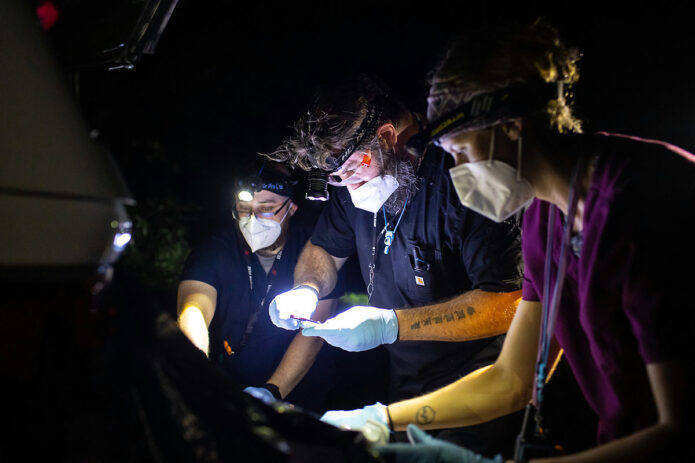
“The bats get dehydrated more quickly and thus need to arouse more frequently,” Haase said. “These more frequent arousals cause the bats to burn through all their winter fat, and they essentially starve to death before the hibernation season is complete.”
As for the gray bat that the team netted on July 18th, “They are an endangered species, which is why we put a band on it so we can track it if it’s recaught,” Haase said. “These bands have unit identifiers on them, ours is FTC for Fort Campbell, so we know where they’ve come from.”
Continuing the Work
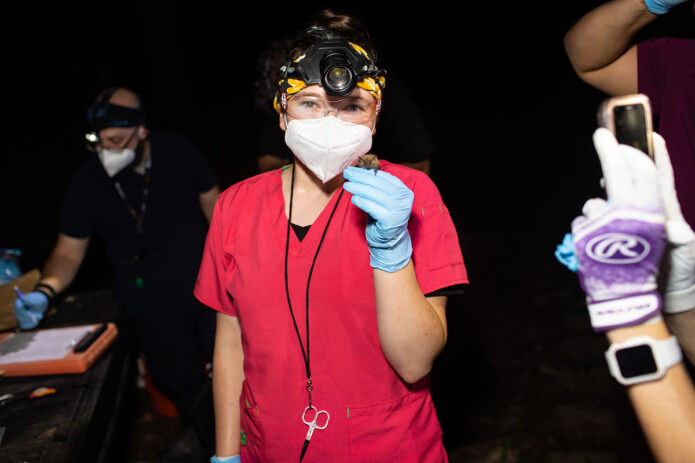
The team’s work for the summer isn’t finished. They’ll continue to net bats at Fort Campbell through the end of August or early September. And Haase hopes that her team will continue the work in the years to come.
The genesis of the Fort Campbell Bat Project centered on the northern long-eared bat, which Haase’s team hasn’t found. But the agreement specified two other species, the tricolored bat, which Haase’s team found and tracked during the week of July 18, and the little brown bat, which the team also hasn’t found. White-nose syndrome has decimated all three species.
“If (tricolored bats) get listed, then there will be specific compliance efforts required by state and federal agencies if one of these species is found on their property,” Haase said. “If the tricolored bat becomes an endangered species, agency-listed species, Fort Campbell may be required to do surveys such as this in the future, which would be a great opportunity for this partnership to continue.”
Meet Dr. Haase’s Team
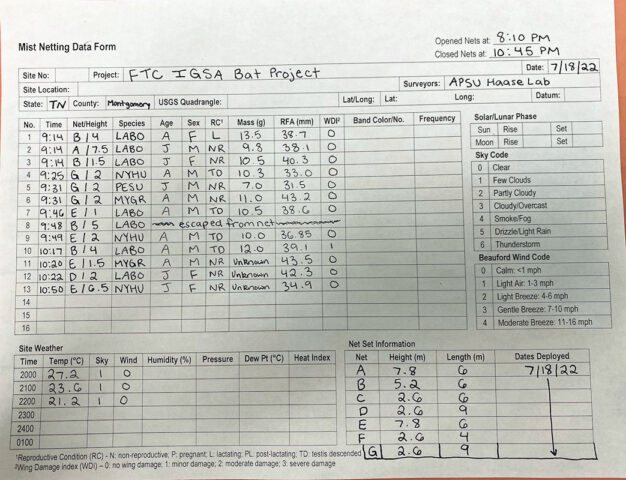
Haase specializes in mammalian ecology. She is primarily interested in ecophysiology, which is the study of how environmental conditions affect mammalian behavior.
Haase’s team, which ranges from current undergraduate biology students to master’s graduates, has similar interests. Here are the students and what they’re studying:
- Sarah Krueger – Recently earned her Master of Science in Biology (MS) at APSU researching the impacts of local climate and disease on reproductive female bats in the Southeast. She is the current Fort Campbell Bat Project coordinator and working to extend her thesis research to juvenile bats.
- Leah Crowley – A new MS student at APSU studying the hibernation behavior of tricolored bats in east Texas culverts and the impacts of white-nose syndrome.
- Brandon Gulley – A new MS student who recently earned his undergraduate degree at Austin Peay State University. He will study bats and white-nose syndrome.
- Dakota Van Parys – An undergraduate biology student and wildlife field technician on the Fort Campbell Bat Project. He will start a long-term study on the impacts of grassland restoration on small mammal communities.
- Jessica Verrillo – A recent biology bachelor’s graduate and wildlife field technician on the Fort Campbell Bat Project.
- Kennedy Beck – An undergraduate biology student volunteering on the Fort Campbell Bat Project. She’ll also start a long-term study of grassland restoration and small mammals.
Many of the students in the Fort Campbell Bat Project accompanied Haase to the International Bat Research Conference and North American Symposium for Bat Research in Austin, Texas, in early August. Krueger and recent MS graduate Trevor Walker presented their bat study research at the conference.

